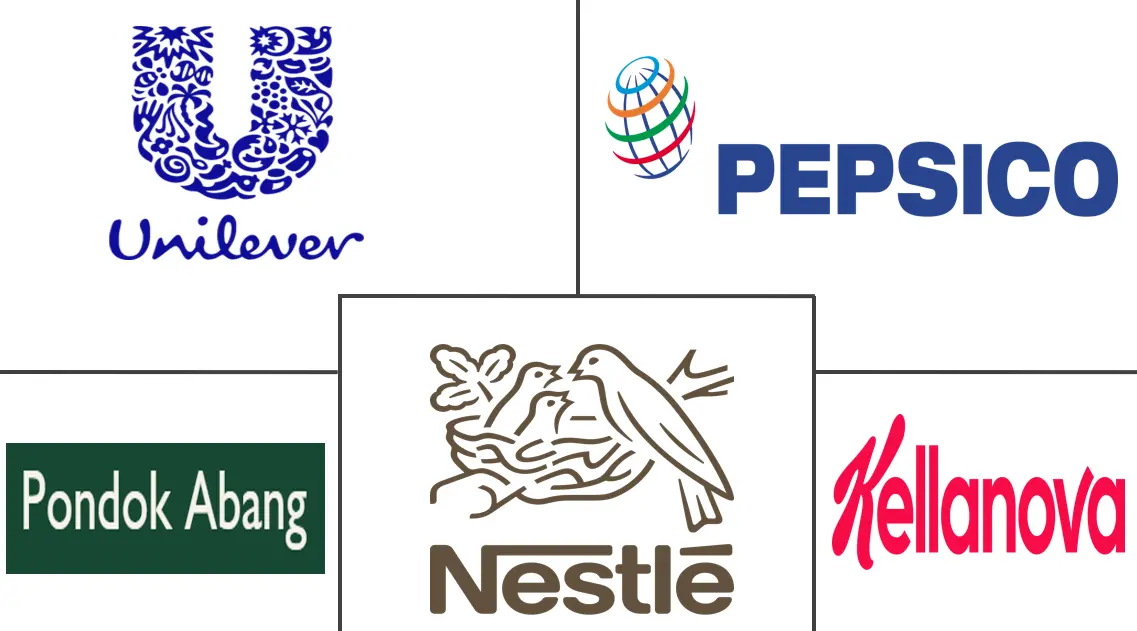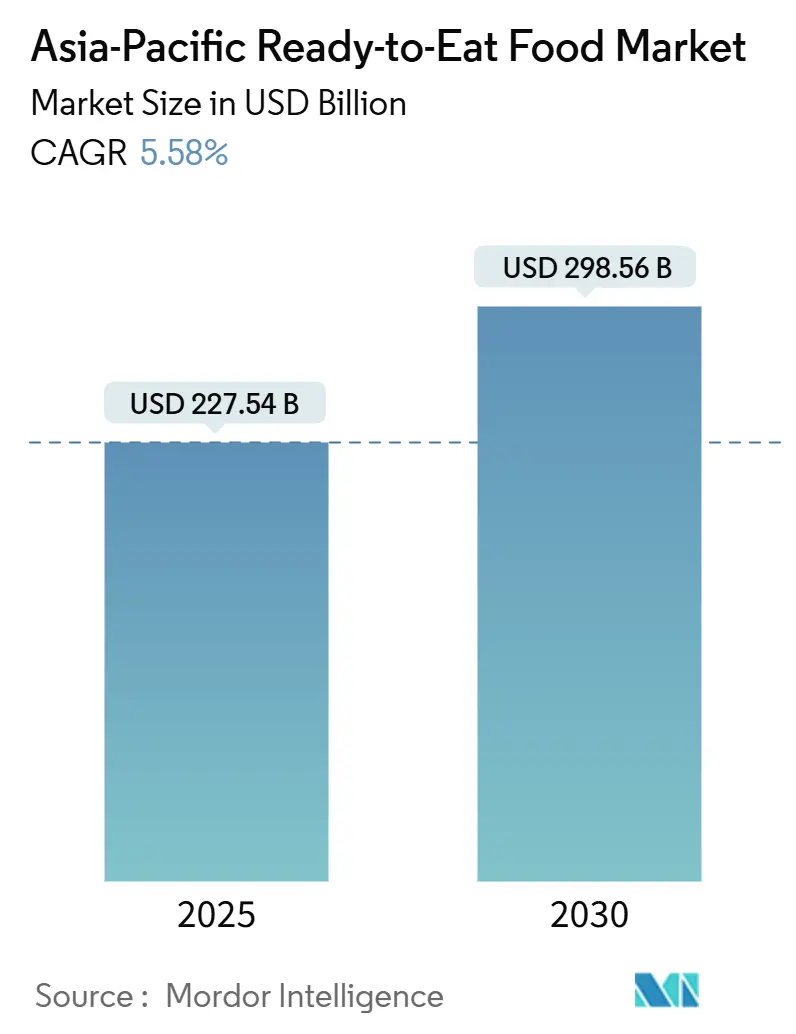
Asia-Pacific Ready-to-Eat Food Market Analysis by Mordor Intelligence
The Asia-Pacific ready-to-eat food market size stands at USD 227.54 billion in 2025 and is on course to reach USD 298.56 billion by 2030, advancing at a 5.58% CAGR. Rapid urbanization, expanding middle-income populations, and busier lifestyles underpin this steady climb, especially in metropolitan hubs where dual-earner families rely on convenient yet nutritious meal solutions. Manufacturers are responding with products that balance flavor, shelf life, and clean-label credentials, while retailers invest in technology-enabled cold chains to maintain quality during distribution. Digital commerce is reshaping consumer access as online platforms widen product choice and shorten delivery windows. In parallel, government incentives from China’s infrastructure programs to India’s Production Linked Incentive Scheme are catalyzing capacity upgrades across processing, packaging, and logistics.
Key Report Takeaways
- By product category, ready meals led with 39.12% revenue share of the Asia-Pacific ready-to-eat food market in 2024, whereas instant soups and snacks are forecast to expand at an 8.05% CAGR through 2030.
- By distribution channel, supermarkets/hypermarkets accounted for 52.05% of the Asia-Pacific ready-to-eat food market size in 2024, while online retail stores are projected to record the fastest 11.54% CAGR between 2025-2030.
- By geography, China commanded 41.04% of regional sales in 2024, whereas India is set to post the quickest 7.03% CAGR over the forecast period.
Asia-Pacific Ready-to-Eat Food Market Trends and Insights
Drivers Impact Analysis
| Driver | (~) % Impact on CAGR Forecast | Geographic Relevance | Impact Timeline |
|---|---|---|---|
| Increasing popularity of Western diets is encouraging ready-to-eat food adoption | +1.2% | China, India, Southeast Asia | Medium term (2-4 years) |
| Growth in dual-income households is driving demand for time-saving meals | +1.5% | Japan, South Korea, Singapore, major cities | Short term (≤ 2 years) |
| Surge in organic and vegan ready-to-eat food launches boosts its demand | +0.8% | Developed markets, expanding to emerging economies | Long term (≥ 4 years) |
| Product innovation and variety are attracting a broader consumer base | +1.1% | Region-wide tech hubs | Medium term (2-4 years) |
| Busy lifestyles and long working hours are promoting convenient eating habits | +1.3% | Large urban agglomerations | Short term (≤ 2 years) |
| Growth in e-commerce platforms is fueling online ready-to-eat food purchases | +0.9% | China, India, Southeast Asia | Medium term (2-4 years) |
| Source: Mordor Intelligence | |||
Increasing Popularity of Western Diets Is Encouraging Ready-to-Eat Food Adoption
Urban millennials and Gen Z are increasingly adopting Western meal formats, like single-serve entrées and breakfast bars, into their routines. Exposure to global cuisines through streaming media and travel has heightened demand for diverse flavors in the Asia-Pacific ready-to-eat (RTE) food market. Brands are localizing sauces and seasonings to suit regional tastes while ensuring convenience for time-conscious consumers. Economic growth, urbanization, and globalization in Asia have shifted diets from traditional staples to Western ones, featuring processed sauces, meats, and oils. The rise of dual-income households and longer work hours has boosted demand for quick Western-style meals like pizza and pasta. Local producers are innovating with Western and ethnic fusion RTE products to meet evolving consumer preferences.
Growth in Dual-Income Households Is Driving Demand for Time-Saving Meals
In the Asia-Pacific, the rise of dual-income households is driving demand for quick meal solutions that retain nutrition and taste. In Japan, the Ministry of Internal Affairs and Communications reported 13 million dual-income households in 2024 [1]Source: Ministry of Internal Affairs and Communications Japan, "Finances are tight for dual-income households too", www.soumu.go.jp. This trend is prominent in urban areas, where long commutes and demanding jobs limit time for traditional cooking. Changing gender roles and increased female workforce participation further fuel this demand. Companies are introducing premium ready-to-eat meals, often using locally sourced ingredients and traditional recipes, to rival home-cooked dishes. Consumers are willing to pay a premium for convenient, high-quality options, supported by rising incomes and a shift in cooking perceptions, especially among younger urban professionals.
Surge In Organic and Vegan Ready-To-Eat Food Launches Boosts Its Demand
Health-conscious and environmentally aware consumers are driving demand for organic and plant-based ready-to-eat products. The Asia-Pacific region is a hub for alternative protein innovations, with Singapore leading regulatory advancements by approving cultivated meat for commercial sale since 2020. Initiatives like the '30 by 30' food security program highlight the government's focus on local alternative protein production [2]Source: Good Food Institute Asia Pacific, "State of Play: APAC", www.gfi-apac.org. This approach is influencing countries like Japan, Australia, and South Korea to develop their frameworks for commercialization. Consumer acceptance has expanded beyond vegetarians to include flexitarians and health-conscious individuals, who value these products for their environmental benefits, taste, and convenience. Educated urbanites increasingly associate plant-based diets with a premium lifestyle and social responsibility. Companies are responding with products that replicate traditional meat textures and flavors while emphasizing sustainability and health. This growth is supported by government policies promoting sustainable food systems and significant investments in alternative protein research and development by major food manufacturers.
Product Innovation and Variety Are Attracting a Broader Consumer Base
Advancements in food processing and packaging technologies are driving product innovations, expanding the appeal of ready-to-eat foods to health-conscious individuals, gourmet enthusiasts, and diverse cultural consumers. These innovations include functional ingredients, customizable portions, and advanced packaging technologies that preserve freshness and extend shelf life without artificial preservatives. Companies are using artificial intelligence and consumer data analytics to identify flavor trends and create products that meet evolving tastes. Partnerships between food manufacturers and tech firms are accelerating innovation, such as smart packaging with real-time freshness alerts and cooking instructions. In the Asia-Pacific region, high smartphone usage and digital engagement enable companies to offer food experiences that integrate digital content, cooking tips, and community interaction.
Restraints Impact Analysis
| Restraint | (~) % Impact on CAGR Forecast | Geographic Relevance | Impact Timeline |
|---|---|---|---|
| Growing health consciousness is limiting the appeal of processed ready-to-eat food | -0.9% | Developed markets, expanding to emerging | Medium term (2-4 years) |
| Concerns over preservatives and additives are affecting consumer trust | -0.7% | Japan, Australia, New Zealand | Long term (≥ 4 years) |
| Inconsistent cold chain logistics hinder product distribution in rural areas | -0.6% | Rural and semi-urban developing markets | Short term (≤ 2 years) |
| Cultural preference for freshly cooked meals reduces ready-to-eat food adoption | -0.8% | Traditional communities | Long term (≥ 4 years) |
| Source: Mordor Intelligence | |||
Growing Health Consciousness Is Limiting the Appeal of Processed Ready-To-Eat Food
In the Asia-Pacific region, growing health consciousness is challenging traditional ready-to-eat food products, especially those seen as overly processed or less nutritious than fresh options. This trend, driven by access to nutritional information, social media influence, and government health campaigns, emphasizes the link between diet and chronic disease prevention. Consumers now scrutinize ingredient lists, nutritional data, and processing methods, demanding transparency that many traditional products struggle to provide. Products high in sodium, sugar, or artificial ingredients conflict with evolving health standards. Companies are responding by reformulating products, reducing sodium, removing artificial preservatives, and adding functional ingredients like probiotics, fiber, and plant-based proteins. However, reformulation requires significant research and development investment and must balance health-focused branding with taste profiles critical for consumer acceptance.
Concerns Over Preservatives and Additives Are Affecting Consumer Trust
Consumers across the Asia-Pacific are increasingly skeptical of food additives and preservatives due to rising health awareness and food safety concerns amplified by social media. An ASEAN food safety report emphasizes the need for better consumer education and communication to address fears over foodborne illnesses and chemical contaminants. These trust issues challenge ready-to-eat foods, which rely on preservatives and processing aids for longevity and safety standards. Regulatory approaches vary across the region, with some countries tightening labeling requirements and others re-evaluating approved additives. This creates compliance challenges for manufacturers operating in multiple markets. Companies are investing in clean-label formulations and natural preservation methods, but these often increase production costs and may compromise product stability or shelf life. Additionally, many consumers mistakenly view natural compounds as safer than synthetic ones, despite identical chemical structures and safety assurances.
Segment Analysis
By Product Type: Ready Meals Drive Market Leadership
Ready meals contributed 39.12% of the Asia-Pacific ready-to-eat food market in 2024, reflecting the broad acceptance of full-plate solutions that only require reheating. Packaging innovations, from microwave-ready trays to self-heating pouches, reinforce leadership by offering restaurant-style experiences at home. Instant soups and snacks, though smaller in absolute terms, are on track to post an 8.05% CAGR from 2025 to 2030 as consumers seek nutritious, portion-controlled options for intermittent snacking occasions. Functional enrichments, such as high-protein lentil bases or collagen-fortified broths, give these lines a health halo that resonates strongly with young professionals and fitness enthusiasts across the Asia-Pacific ready-to-eat food market.
The diversification of cereals and breakfast bars aligns with the increasing demand driven by early-morning time constraints. Premium breakfast SKUs now incorporate organic oats, reduced sugar, and probiotic infusions, enabling higher average selling prices and maintaining strong profit margins. Baked goods continue to gain traction by leveraging localized flavors, such as pandan-flavored cakes in Southeast Asia and matcha sponge rolls in Japan. In contrast, meat-based ready meals face growing environmental scrutiny, prompting processors to adopt hybrid meat-plant formulations.
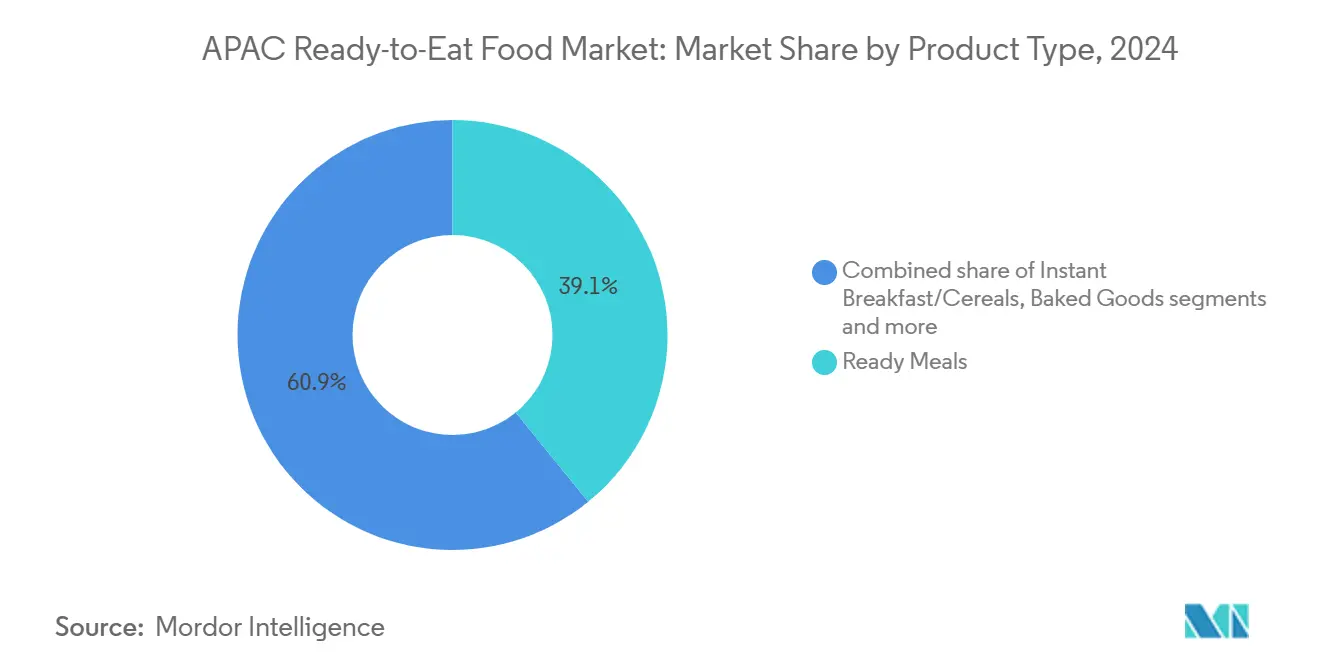
Note: Segment shares of all individual segments will be available upon report purchase
By Distribution Channel: Digital Transformation Reshapes Retail
Although supermarkets and hypermarkets held 52.05% share of the Asia-Pacific ready-to-eat food market in 2024, footfall patterns continue to fragment. Shoppers still value in-store product inspection and family-sized bulk deals, yet the convenience of app-based ordering is eroding brick-and-mortar exclusivity. Online outlets are forecast to expand at an 11.54% CAGR to 2030, powered by fast-growing mobile payments and improved logistics. The Asia-Pacific ready-to-eat food industry now treats live-inventory visibility, same-day shipping, and temperature guarantees as standard features rather than add-ons.
Convenience stores flourish in bustling neighborhoods, providing late-night access, handpicked snack selections, and microwave stations for on-the-spot consumption. Specialty retailers, typically emphasizing organic or ethnic products, leverage brand storytelling and sampling events to validate their premium pricing. Newer avenues, such as smart vending machines and pantry contracts at workplaces, not only boost volume but also enhance consumer engagement, solidifying the Asia-Pacific ready-to-eat food market's foothold in daily life.
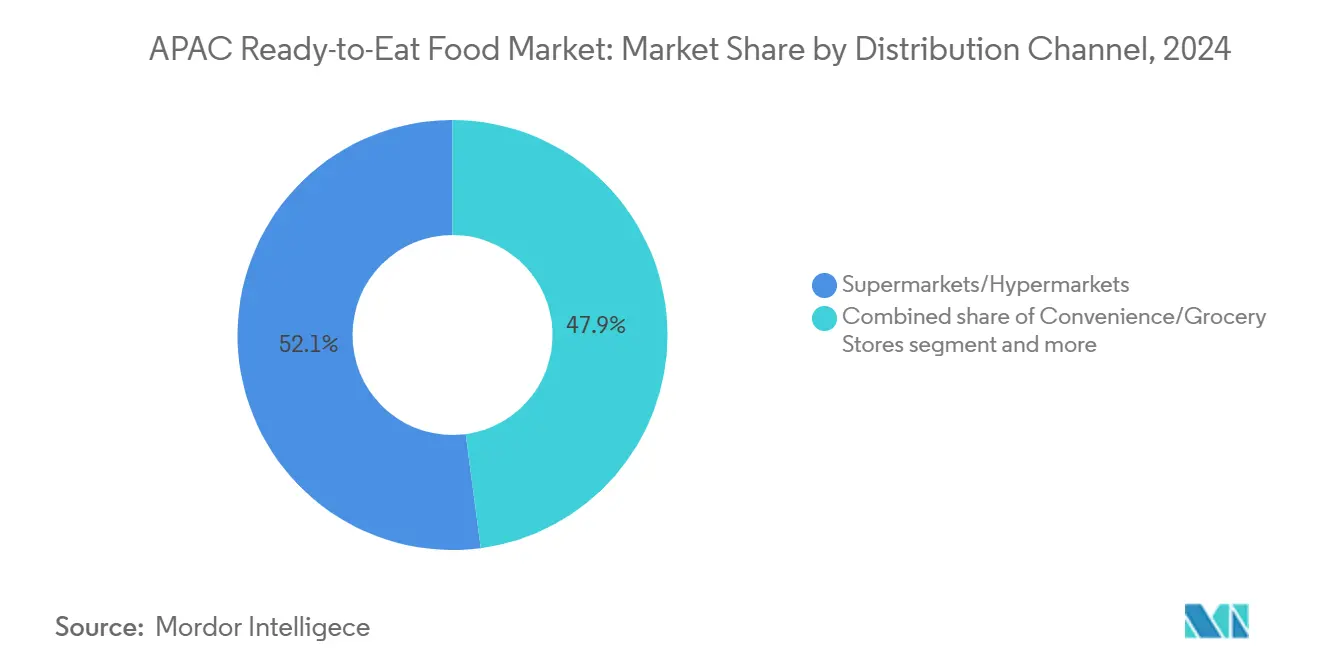
Note: Segment shares of all individual segments will be available upon report purchase
Geography Analysis
China holds a dominant 41.04% share in the Asia-Pacific ready-to-eat food market. The rapid growth of e-commerce platforms, with food categories experiencing double-digit expansion, is driving online adoption. Government initiatives, including incentives for manufacturing parks and stricter safety regulations, are enhancing supply chain reliability and boosting consumer confidence. Additionally, consumer preferences are becoming increasingly diverse.
India, anticipated to grow at a 7.03% CAGR through 2030, is leveraging PLISFPI funding of INR 10,900 crore to strengthen its ready-to-cook and ready-to-eat segments [3]Source: Ministry of Food Processing Industries, "Production Linked Incentive Scheme Updates", www.mofpi.gov.in. The expanding middle-income population and increasing smartphone penetration are raising awareness of these categories. Meanwhile, hyper-local flavors, such as masala khichdi bowls and millet-based upma, ensure cultural relevance. Investments in state-level infrastructure, including road networks and cold storage facilities, are further driving the Asia-Pacific ready-to-eat food market in semi-urban areas, where modern retail formats are still developing.
Japan and South Korea represent mature markets. In South Korea, the growing number of single-person households is fueling demand for microwave-ready meals designed for individual servings. In Southeast Asia, Thailand is balancing strong domestic sales with significant export activity, creating opportunities for both local and imported products. Australia and Singapore, characterized by higher per-capita incomes and stringent labeling standards, are witnessing a shift toward premium, health-focused product offerings.
Competitive Landscape
The Asia-Pacific ready-to-eat food market features a moderate fragmentation, with numerous domestic and multinational players vying for a larger share of the market. The key players are adopting strategic approaches such as mergers, acquisitions, partnerships, and expansions, as well as focusing on new product development to enhance their brand presence among consumers. The leading companies dominating the regional market include PepsiCo Inc., Nestlé SA, Kellanova, Pondok Abang, and Unilever PLC, among others. Further, the companies have been introducing new and innovative products with the inclusion of naturally derived ingredients so as to make their product unique from the existing products. Owing to the rapidly developing nature of the market, new product innovation has become the most commonly used strategy, as it helps in understanding the changing needs of the consumers in the market.
Investment in infrastructure is a decisive differentiator. Companies with integrated cold-chain assets shorten lead times and cut spoilage, critical for protein-rich ready dishes. Thailand's CP Foods, for instance, has expanded its RTE portfolio through vertically integrated supply chains across Southeast Asia, aligning with local consumption patterns while ensuring freshness. In China, domestic leaders partner with e-commerce giants to leverage real-time analytics for micro-segmented campaigns that reduce stock-outs.
Sustainability narratives shape competitive positioning. Producers race to adopt recyclable trays, mono-material pouches, and renewable-energy processing plants that align with corporate ESG commitments and tightening regulations. Technology collaborations are multiplying: food tech startups contribute AI-driven sensory mapping, while packaging suppliers offer oxygen-scavenger films that prolong shelf life without synthetic preservatives. These alliances keep the Asia-Pacific ready-to-eat food market in constant innovation mode while raising the barrier for late entrants.
Asia-Pacific Ready-to-Eat Food Industry Leaders
-
PepsiCo Inc.
-
Pondok Abang
-
Nestlé S.A.
-
Unilever PLC
-
Kellanova
- *Disclaimer: Major Players sorted in no particular order
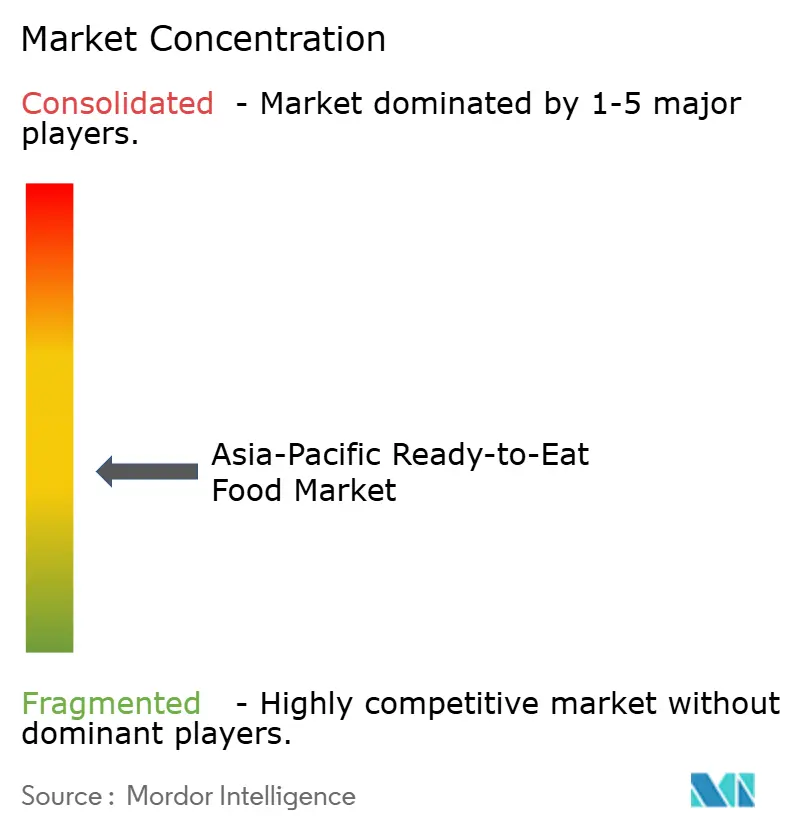
Recent Industry Developments
- April 2025: DayDayCook, a leading Asian consumer food company, has signed a binding agreement to establish a joint venture (JV) with Hewen Agricultural Technology Limited. Hewen, recognized for its premium prepared meals, aims to expand the delivery of ready-to-eat (RTE) solutions. Their target market includes major e-commerce platforms, and direct-to-consumer brands across Mainland China.
- July 2024: Sevenoaks Foods, an Australian startup, unveiled a new range of ready-to-eat meals for kids. The brand emphasizes that its offerings are free from artificial colors and flavors, contain reduced salt, have no added sugars, and are crafted using genuine ingredients.
- March 2023: Goeld, a prominent frozen food company in India, unveiled its latest product lineup, now available at Reliance Retail stores nationwide. The newly introduced range of frozen food offerings includes Pizza Pockets, Paneer Pakodas, and Idlis.
- January 2023: Beyond Meat, Inc. joined forces with Fresh Kitchen, a wholly-owned brand of the prominent freshly prepared food provider Bakkavor China, to launch ready-to-eat (RTE) meals featuring Beyond Meat's plant-based meat products in the region. Together, these two brands are introducing a new line of convenient RTE meals designed for consumption at home or on the go.
Research Methodology Framework and Report Scope
Market Definitions and Key Coverage
Our study defines the Asia-Pacific ready-to-eat (RTE) food market as all retail-packaged or food-service meal components that require no further cooking before consumption, including chilled, frozen, shelf-stable, and ambient offerings across breakfast items, baked goods, instant snacks, ready meals, and meat products.
Scope Exclusion: Freshly prepared food sold loose in restaurants, canteens, and street stalls sits outside this scope.
Segmentation Overview
-
By Product Type
- Instant Breakfast/Cereals
- Instant Soups and Snacks
- Ready Meals
- Baked Goods
- Meat Products
- Other Product Types
-
By Distribution Channel
- Supermarkets/Hypermarkets
- Convenience/Grocery Stores
- Speciality Stores
- Online Retail Stores
- Other Distribution Channels
-
By Geography
- China
- India
- Japan
- Australia
- Indonesia
- South Korea
- Thailand
- Singapore
- Rest of Asia-Pacific
Detailed Research Methodology and Data Validation
Primary Research
Mordor analysts conducted interviews with processors, cold-chain operators, retail buyers, and online grocery executives across key economies. Discussions validated secondary volumes, explained price dispersion between chilled and frozen SKUs, and flagged emerging claims such as preservative-free lines that alter average selling prices.
Desk Research
We began with national statistics bureaus, customs trade dashboards, and nutrition intake surveys across China, India, Japan, Australia, Indonesia, South Korea, and Thailand, which clarified production, import, and consumption patterns. Trade association releases, such as the Japan Frozen Food Association and the Federation of Indian Chambers of Commerce & Industry, helped us benchmark output volumes and category splits. Company annual reports, investor decks, and reputable business press added price points and channel mix trends. Where needed, we mined D&B Hoovers for private-company sales and Dow Jones Factiva for deal flow and expansion stories. The source list is illustrative, not exhaustive.
Market-Sizing & Forecasting
A top-down demand pool was built from household food-expenditure data, adjusted for RTE penetration by income group, then corroborated with sampled supplier roll-ups and average SKU pricing to refine totals. Key variables include urbanization rate, dual-income household share, supermarket density, average RTE spend per capita, cold-storage capacity, and cross-border e-commerce traffic. Multivariate regression models projected each driver to 2030; bottom-up checks filled gaps where channel data were thin.
Data Validation & Update Cycle
Outputs pass anomaly checks, peer review, and a senior analyst sign-off. We refresh the model annually and issue interim updates after material events such as major food-safety regulations or currency swings.
Why Mordor's APAC Ready To Eat Food Baseline Commands Reliability
Published estimates often diverge because publishers choose different product baskets, geography rolls, and currency treatments.
Key gap drivers include exclusion of chilled bakery extensions by some firms, reliance on constant 2010 USD conversion, and slower refresh cadences that miss rapid online grocery gains. Our model, updated with 2024 spending data and validated through supplier interviews, captures the full chilled, frozen, and shelf-stable continuum and reflects up-to-date exchange rates.
Benchmark comparison
| Market Size | Anonymized source | Primary gap driver |
|---|---|---|
| USD 227.54 billion (2025) | Mordor Intelligence | - |
| USD 183.67 billion (2024) | Regional Consultancy A | Omits chilled bakery, limited online channel coverage, older FX |
| USD 37.73 billion (2024) | Industry Data Provider B | Counts only meat snacks and modern retail, constant 2010 USD |
These comparisons show that our disciplined scope selection, timely data inputs, and dual-track validation provide a balanced, transparent baseline that decision-makers can reproduce and trust.
Key Questions Answered in the Report
What is the current value of the Asia-Pacific ready-to-eat food market?
The Asia-Pacific ready-to-eat food market size is USD 227.54 billion in 2025 and is projected to reach USD 298.56 billion by 2030.
Which product segment leads regional revenue?
Ready meals hold the top position, accounting for 39.12% of 2024 sales across the Asia-Pacific ready-to-eat food market.
How fast is online retail expanding in this space?
Online channels are forecast to grow at an 11.54% CAGR from 2025-2030, the fastest among all distribution modes.
Which country is the fastest-growing market?
India is expected to register a 7.03% CAGR through 2030, benefiting from government incentives and rising urban incomes.
